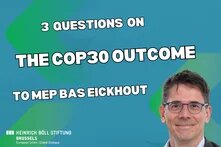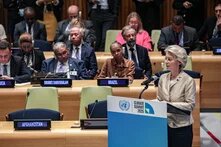COPs are a time of a plethora of announcements, pledges and initiatives by countries, businesses and financial institutes. It is hard to keep up and even harder to distinguish between newsworthy reason for hope and old wine in new bottles. Lisa Tostado reports on the climate “communication nightmare” of welcoming progress while emphasizing the persistent astronomical gap to what would be Paris Agreement-compatible.

In her speech last Friday, climate activist Greta Thunberg claimed COP26 to be failure and a greenwash festival, full of empty promises. To what extent is that true? The COP26 climate summit in Glasgow is still ongoing. No final outcome document can be assessed at this point. A closer look at different announcements and the overall context of climate negotiations can provide some answers, though. Spoiler alert: they are not simple and it is crucial to look into details rather than relying on catchy headlines.
Coal
Patrick Galey, a global environment and science correspondent, lamented that media tend to take on good faith prima facie claims from the British government, resulting in too rosy reporting on COP26. One of his examples was the Global Coal to Clean Power Transition Statement, which have made big headlines during the first week of COP. It commits the 46 signees to four points: (1) building clean, (2) phasing out coal, (3) stop building new coal, and (4) ensuring the coal phase-out is a just transition. The new climate ambition is undoubtedly on the section of phasing out coal, with the 2030s for major countries, and the 2040s for the rest of the world. The agreement means that now half of the world’s coal countries have a coal phase-out commitment. Three of the top ten global coal power countries, all of them in Asia where 80% of the world’s coal generation is taking place, are included.
At closer look, the pledge is less impressive as many countries had already committed to phasing out (in the framework of the Powering Past Coal Alliance from 2017) or do not even have coal power plants. Top coal countries are not part of the pledge either, which makes big headlines about “the end of coal” overly optimistic. Lastly, even these new dates for coal phase-out are not 1.5 degree-aligned. In conclusion, Galey said what I feel apply to many different announcements during this COP: “I’m absolutely not saying this announcement is worthless. It includes coal phase out pledges from Korea, Indonesia and Vietnam and includes countries that account for 13% of coal capacity globally. But why not just say that?”
In addition, some countries have already started to walk back on their coal commitments. South Korea, for example, was signatory to the pledge but the government now says it never agreed on a phase-out date and was just “working towards it”. In a similar U-turn, just a few hours after the Polish government signed the commitment to exit coal, Climate and Environment minister Anna Moskwa said Poland was not a “major” economy and was still planning on phasing out coal by 2049.
The United States are also doing some limbo on coal. The U.S. resisted putting a target date to phase out domestic coal power, i.e. they are not a signatory to the coal phase out pledge, but John Kerry made some comments about still ending coal in 2030. Later on, a spokesperson said net-zero electricity plans still would allow coal with carbon capture technology (with a very questionable record). The Biden administration has handled its stance on coal carefully, in part to avoid irking Sen. Joe Manchin, a key Democratic vote from coal-heavy West Virginia who could sink a White House and Democratic $1.75 trillion social spending bill that includes 555 billion USD for climate-related measures.
Deforestation
On the second day of COP26, more than 100 governments signed on to the Glasgow Leaders’ Declaration on Forest and Land Use to halt deforestation by 2030. UK Prime Minister Boris Johnson described called it an unprecedented landmark agreement and Michelle Passero of The Nature Conservancy told Al Jazeera that the Declaration was a “terrific start” to COP26.
However, similar announcements have been made in the past, without delivering sufficient results. The New York Declaration on Forests (NYFD), concluded seven years ago, is a political declaration that brings together governments, companies and civil society actors with the common aim of ending deforestation by 2030. A five-year assessment report about it from 2019 found that “instead of slowing down, tropical deforestation has continued at an unsustainable pace since the adoption of the NYDF. Since 2014, the world has lost an area of tree cover the size of the United Kingdom every year.”
Besides the aim to end deforestation, the declaration included funding pledges as in the case of the EU, for example. However, little is known about how this money will be spent. A significant amount may be channelled via the World Bank’s Forest Carbon Partnership Facility which, despite more than 1 billion USD funding, has failed to achieve significant results. And again, much of the public funding had already been confirmed on earlier occasions.
This COP’s declaration includes some important countries which had not signed before, such as Brazil, China and Russia. Yet, such non-binding ad-hoc commitments may not prove to be a game changer in these countries. It also seems that Indonesia is already stepping back from its signature, which, indeed, is at odds with development projects approved by the Indonesian government and likely to lead to 135.9m acres of forest cut down by 2040. Siti Nurbaya Bakar, the environment minister for the Southeast Asian archipelago, which is home to the world’s third-biggest rainforest, said on Wednesday that “forcing Indonesia to zero deforestation in 2030 is clearly inappropriate and unfair”. A spokesperson for the UK government then explained the pledge was about ending net deforestation and that there was no contradiction in Indonesia’s statements.
If the EU wants to be a credible defender of forests, it must change its stance on biomass in the framework of the Fit-for-55 Package. External costs from burning biomass (from GHG emissions, air pollution, biodiversity loss and habitat destruction) are currently not adequately mitigated or priced in. Current sustainability criteria consider burning forest wood renewable and carbon neutral despite research suggesting otherwise. Subsidies for biomass have further spurred demand and therefore the logging of forests outside the EU. Given current levels of atmospheric CO2, it is not only ill advised to burn carbon sinks rather than let them grow, but we also do not have the luxury of time for trees to grow back.
In a nutshell, the Glasgow Leaders’ Declaration on Forest and Land Use includes more countries and some more funding pledges, but it not unprecedented and it is unclear to which extent signatories will act on their commitments. It is therefore not quite clear how this agreement will be different from previous attempts that have failed to halt deforestation, but it will be important to track development.
Fossil fuel finance
On 4 November 2021, more than 20 countries and institutions, including some of the largest historic providers of public finance for fossil fuels such as the US or the European Investment Bank, launched a joint statement committing to end direct international public finance for unabated coal, oil, and gas by the end of 2022 and prioritise clean energy finance. For the first time, this announcement takes into account oil and gas as opposed to addressing only coal.. This is an important step given that the International Energy Agency says that 2021 needs to mark the end of new investments in all fossil fuels to limit global heating to 1.5°C. Despite that, new research shows that between 2018 and 2020, G20 governments and multilateral development banks still spent at least 63 billion USD on fossil fuels abroad.
If implemented effectively this initiative could directly shift more than 18 billion USD a year out of fossil fuels and into clean energy. Half of signatories are developing countries, which is a strong political signal to energy financiers that the argument that these countries need more fossil duel finance for economic growth is a constructed reality. Tasneem Essop, Executive Director, Climate Action Network International, considers the announcement a step in the right direction, even though significant scaling up is necessary. There are also concerns around the term “unabated” which can open the door to unproven and unreliable carbon capture and storage technologies that hide the lack of ambition.
News from the European Commission also show that finance remains an issue, even among the alleged climate leaders. The European Commission is working on the 5th list of Projects of Common Interest (PCI) on cross border energy infrastructures. The delegated act will include fossil gas projects and make them eligible for EU public funding and accelerated permitting procedures. The EU taxonomy for sustainable finance is also likely to include fossil gas. Yet, according to the European Commission itself, the EU needs to reduce gas consumption by 36% by 2030.
On a more positive note: The move away from all fossil fuels does not only concern finance, as exemplified by the Beyond Oil and Gas Alliance, Costa Rica and Denmark. It is the first diplomatic initiative focused on the need to end the expansion of all fossil fuel production. It will bring together countries and subnational jurisdictions that have ended new licensing rounds for oil and gas exploration and production, or have taken steps towards it, and commit to phase out their existing production on a Paris-aligned timeline. As such, this COP has raised energy issues and fossil fuel phase-out more than any other has. Yet, a lot more (serious) signatories are needed make sure this is locked in for all future COPs.
Number crunching
There has also been some confusion about expected global heating and changes as a result of announcements at COP. Numbers below 2 °C have made headlines, but those estimates were based on long-term net zero goals set out by countries including India, the world’s third-biggest emitter, which is aiming for 2070. An assessment from Climate Action Tracker, the world’s most respected climate analysis coalition, is based on countries’ short-term goals for the next decade and finds us on a path of 2.4 ° temperature increase. It is important to keep in mind that many such calculations rely on pledges that are per se no guarantee that governments will deliver on them – and to interpret them accordingly. If current policies and measures are taken into account, rather than just goals, heating would rise to 2.7 °C.
Greenpeace found a good allegory for the net zero pledges: “It is like saying I am going to run a marathon some day, doing no training and still tell people I’m a marathon runner.”
The UNCCC Process
Mohamed Adow from Powershift Africa sees two realities in Glasgow: “One is the world of press releases by the UK Government announcing a host of initiatives such as 'an end to coal', which suggest all is well and we've as good as cracked the climate crisis. The other reality is outside this PR bubble. The climate deals in cold hard facts." According to him, the announcement blitz is distracting from the core structure of the UNFCCC process, where countries are negotiating with each other and there is more accountability than in just a pledge. This is especially relevant as discussions on climate finance and loss and damage have remained contentious with developed countries continuing to duck their responsibilities. Concerning adaptation, for example, Adow describes the two realities as a public one in which richer countries claim to care about adaptation and an inside one where they undermine efforts to prioritise the adaptation needs of vulnerable nations and push for most of the money still going towards emission reductions. It is also a question of grants versus loans. The Adaptation Fund announced during the first week of COP26 is much more generous than previous commitments and includes new first-time contributors, but still falls very short on adaptation needs in climate vulnerable countries.
Looking at the described “second reality”, War on Want’s Asad Rehman sees parallels with the failed COP15 in Copenhagen, but is hopeful when looking at the increased public pressure stemming from the climate justice movement.
Earlier this week, there was a coordinated effort by civil society observers, who contacted reporters to raise the alarm over what they claimed to be fence sitting by delegates from the U.S. and the EU. This brief against their traditional allies signals how desperately NGOs view the current state of negotiations.
A balancing act
It a communication balancing act: Yes, there has been progress. Yes, some measures were unthinkable until recently. Still, we are far from on a path that would justly limit average global temperature rise to 1.5 ° C – emissions rise at a time where they would need to decrease by 45%. At closer examination, many pledges look less impressive. A Twitter user found himself in the same struggle, a “communication nightmare”: “I want to praise how fast changes are compared to the political reality just a few years ago and condemn how slow they are compared to the physical reality and its consequences”.
In my view, the assessment of climate policy should not be made against past failures but against what all signatories had committed to in Paris and therefore against the physical realities which would ensure a liveable planet. Yet, I disagree on with Greta Thunberg that “making some progress” equals losing and COP26 is a failure unless we achieve immediate, drastic, unprecedented, annual emission cuts. Because of tipping points and self-reinforcing feedback loops in the climate system, the question has indeed fewer shades of grey than other political issues. It is nevertheless not purely black and white. The UNCCC process is the only global process we have right now and every degree closer to the Paris Agreement goals counts.


